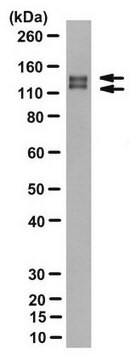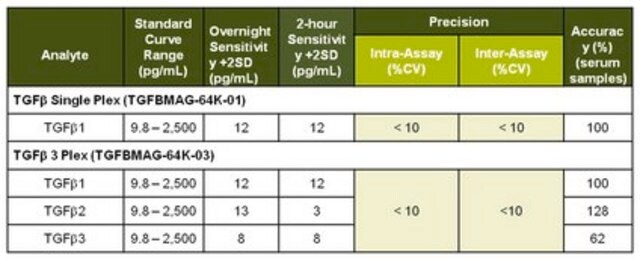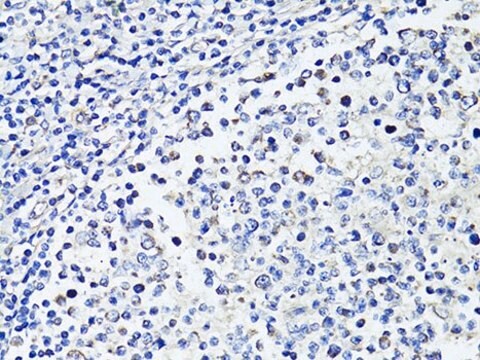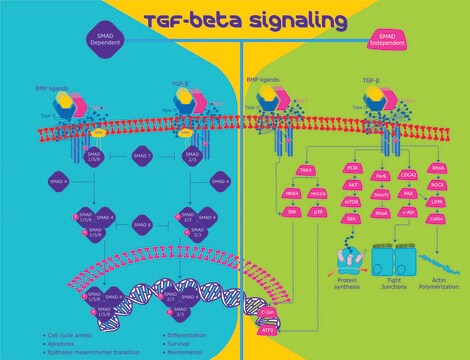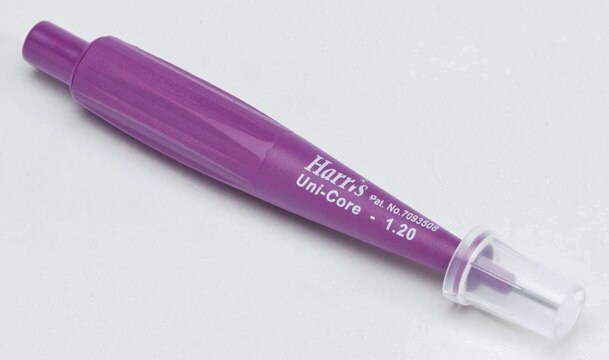MABC1126
Anti-EGFRvIII mutation Antibody, clone L8A4
clone L8A4, from mouse
Sinonimo/i:
Epidermal Growth Factor Receptor vIII
About This Item
Prodotti consigliati
Origine biologica
mouse
Forma dell’anticorpo
purified immunoglobulin
Tipo di anticorpo
primary antibodies
Clone
L8A4, monoclonal
Reattività contro le specie
human
Confezionamento
antibody small pack of 25 μg
tecniche
ELISA: suitable
flow cytometry: suitable
immunocytochemistry: suitable
immunohistochemistry (formalin-fixed, paraffin-embedded sections): suitable
western blot: suitable
Isotipo
IgG1κ
N° accesso NCBI
N° accesso UniProt
modifica post-traduzionali bersaglio
unmodified
Descrizione generale
Specificità
Immunogeno
Applicazioni
Apoptosis & Cancer
Immunohistochemistry (Paraffin) Analysis: A representative lot detected EGFRvIII mutation in Immunohistochemistry applications (Mellinghoff, I.K., et. al. (2005). N Engl J Med. 353(19):2012-24; Sok, J.C., et. al. (2006). Clin Cancer Res. 12(17):5064-73).
Immunohistochemistry Analysis: A representative lot detected EGFRvIII mutation in Immunohistochemistry applications (Wikstrand, C.J., et. al. (1998). J Neuroviral. 4(2):148-58; Wikstrand, C.J., et. al. (1995). Cancer Res. 55(14):3140-8).
ELISA Analysis: A representative lot detected EGFRvIII mutation in ELISA applications (Wikstrand, C.J., et. al. (1998). J Neuroviral. 4(2):148-58; Wikstrand, C.J., et. al. (1995). Cancer Res. 55(14):3140-8).
Flow Cytometry Analysis: A representative lot detected EGFRvIII mutation in Flow Cytometry applications (Wikstrand, C.J., et. al. (1998). J Neuroviral. 4(2):148-58; Wikstrand, C.J., et. al. (1995). Cancer Res. 55(14):3140-8).
Immunocytochemistry Analysis: A representative lot detected EGFRvIII mutation in Immunocytochemistry applications (Wikstrand, C.J., et. al. (1998). J Neuroviral. 4(2):148-58; Batra, S.K., et. al. (1995). Cell Growth Differ. 6(10):1251-9).
Qualità
Western Blotting Analysis: 1 µg/mL of this antibody detected EGFRvIII mutation in NR6 cells expressing human EGFRvIII (NR6M).
Descrizione del bersaglio
Stato fisico
Stoccaggio e stabilità
Handling Recommendations: Upon receipt and prior to removing the cap, centrifuge the vial and gently mix the solution. Aliquot into microcentrifuge tubes and store at -20°C. Avoid repeated freeze/thaw cycles, which may damage IgG and affect product performance.
Altre note
Esclusione di responsabilità
Non trovi il prodotto giusto?
Prova il nostro Motore di ricerca dei prodotti.
Codice della classe di stoccaggio
12 - Non Combustible Liquids
Classe di pericolosità dell'acqua (WGK)
WGK 2
Certificati d'analisi (COA)
Cerca il Certificati d'analisi (COA) digitando il numero di lotto/batch corrispondente. I numeri di lotto o di batch sono stampati sull'etichetta dei prodotti dopo la parola ‘Lotto’ o ‘Batch’.
Possiedi già questo prodotto?
I documenti relativi ai prodotti acquistati recentemente sono disponibili nell’Archivio dei documenti.
Il team dei nostri ricercatori vanta grande esperienza in tutte le aree della ricerca quali Life Science, scienza dei materiali, sintesi chimica, cromatografia, discipline analitiche, ecc..
Contatta l'Assistenza Tecnica.